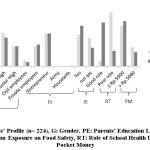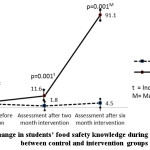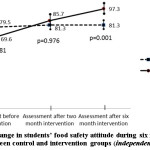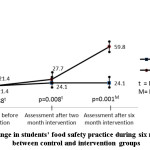Introduction
In Indonesia, more school students are depending on street foods for their breakfast and meal as the number of housewives and mothers going to work has raised.1 In Asian countries, street food at one hand, plays an important role in the provision of daily food as it supplies 88% energy intake.2 On the other hand, street foods pose food born health risks. Studies from Malawi, Zimbabwe, South Africa, Hong Kong, and Bangladesh revealed that most of street food contained bacteria, textile dyes and formaldehyde.3−7 A study in Bekasi District, West Java, Indonesia found that four out of eight street food samples contained textile dye, artificial sweetener (saccharine, cyclamate) and formaldehyde.8 Another study in 2015 from 13 provinces in Indonesia showed 45% of street food out of 2984 food samples sold around elementary school and surrounding area were physically (15%), chemically (5%) and microbiologically (20%) contaminated by hazardous materials.9 Therefore, street food safety is very important to prevent food borne diseases such as diarrhea and food poisoning.10 Moreover studies from Turkey, Malaysia, and Indonesia revealed that most of the elementary school students have poor knowledge about street food safety.11−15 Therefore, elementary schools constituted places where food poisoning cases mostly occurred after the household.9
Several food borne diseases from contaminated street food and beverages were diarrhea and hepatitis. A study in Indonesia taken from population of all households in 33 provinces, 497 districts/cities using cross sectional study design reported 35971 (3.5%) cases of diarrhea and 12333 (1.2%) cases of hepatitis out of 1,027,763 (3.5%) samples. The leading types of hepatitis were Hepatitis B (21.8%), Hepatitis A (19.3%) and Hepatitis C (2,5%).16 In 2015, food poisoning cases in Indonesia were reported 88 cases with 525 casualties, in which 13 (15%) of them were caused by street food.9 At the same year, the worst cases of the food poisoning occurred in West Java. One case occurred in a Public Elementary School (PES) Tasikmalaya City resulted in 117 students suffered street food poisoning.9 Another case occurred in Cimahi City, where 38 students from four elementary schools (SD) suffered from food poisoning after consuming street food sold around their schools.17 The problem of food safety, therefore, must be prevented and promotion regarding street food safety must be done continuously. The promotion can be done using various approaches to improve the behavior of stdents as the primary consumers. Since behavior is formed from knowledge, attitude, and practice, the success of behavioral change can be done through health education using various media.18 Studies from America, Korea, Turkey, and China using printed and electronic media showed that they could increase knowledge, attitude, and practice towards health awareness among students.19−26 However, those studies did not assess a change in knowledge, attitude, and practice of street food safety in elementary school students. Therefore, we conducted this study to assess food safety education with different media i.e. book covers and videos in order to improve knowledge, attitude, and practice of street food safety of elementary school students.
Materials and Methods
Ethical Consideration
This study had been approved by the Ethics Committee for Health Research, School of Public Health, University of Diponegoro, with Ethical Clearance Number 128/EC/FKM/2016.
Selection of Subjects
This quasy experiment with pretest-posttest control group study was done in Cimahi City, West Java, Indonesia. The study population was all of the PES students in Cimahi City and from the study population, two groups were selected i.e. intervention and control groups. We selected the intervention group from four public elementary schools in South Cimahi City where food poisoning had occurred, and the control group from four public elementary schools in North Cimahi City by simple random sampling. The intervention group samples consisted of 112 fourth graders in which they were given intervention on street food safety using book covers and videos. The control group samples consisted of 112 fourth graders in which they were given non street food safety education i.e. hands washing. A total of 224 students from control and intervention groups were assessed for their knowledge, attitude, and practice on street food safety. The subjects were sampled on the basis of inclusion criteria i.e. 1) PES students at grade four, and 2) PES students with pocket money given at least three times a week.
The study was conducted for six months, in which food safety education was given once a week within 50-60 minutes duration. We distributed ten (10) kinds of book covers to each students at the first week of intervention to be attached (as cover) on their note books. The ten book covers were assigned for ten subjects notebook namely Math, Science, Social, Indonesia, Civic, Sundanese, Art And Culture, Sport, English, and Moslem Religion. The book covers consisted of materials on bacteriological and chemical food safety (see figure 1) and the themes of each book covers were listed on table 1.
Table 1: The themes of each book covers
|
Book cover |
Theme |
|
1 |
The cause of unsafe street food and effects of consuming bacteriologically unsafe street food |
|
2 |
Bacteriologically safe street food criteria |
|
3 |
Chemically safe street food criteria |
| 4 |
Chemically unsafe street food characteristics and effects of consuming it |
|
5 |
The ways of assessing packaged street food which were unsafe to consume |
| 6 |
Roasted street food criteria which were unsafe to consume |
| 7 |
Unhealthy street food vendors |
|
8 |
Improper use of cooking oil |
|
9 |
The ways to choose safe street food and the effect of consuming unsafe street food |
|
10 |
Being smart of choosing clean and healthy street food |
 |
Figure 1: Ten (10) book covers consisted of materials on bacteriological and chemical food safety. There were ten subject note books with one book cover attached on each book Click here to View figure |
We then showed 2 videos covering materials on bacteriological and chemical food safety, each within 22 minutes duration. The following weeks, we checked whether the book covers were still attached on their subject books. We then gave education on food safety which involved teachers from school health unit. The food safety education was given through book covers every week while videos were given for 3 (three) times within 6 month. The videos were taken from official site of Indonesia National Agency of Drug and Food Control (BPOM) with materials consisted of (1) getting to know safe street food; (2) purchasing safe street food; (3) reading street food packaging labels; (5) learning food borne diseases. The same videos were shown again at the third and sixth month of intervention.
Assessment of street food safety knowledge, attitude, and practice of the students
To assess street food safety knowledge of the students we used questionnaires consisted of 20 questions comprising 10 multiple choice questions, 5 short essays, and 5 essays. We scored 1 for each correct answer and 0 for each wrong answer. The maximum score of food safety knowledge of the students was 20 and the minimum one was 0. We then classified the food safety knowledge of the students into two categories, namely good (total score of >75%) and poor (total score of ≤75%). Assessment was done three times; before the first intervention (before the book covers were distributed and before the videos were shown), after the second intervention (after the first and second videos were shown) and after the third intervention (after the last videos were shown).
To assess street food safety attitude of the students we used questionnaires consisted of 22 questions using Likert Scale ranging from strongly agree, agree, somewhat disagree, and disagree. For positive statement, we scored 4 for “strongly agree”, 3 for “agree”, 2 for “somewhat disagree” and 1 for “disagree”. For negative statement, we scored 1 for “strongly agree”, 2 for “agree”, 3 for “somewhat disagree”, and 4 for “disagree”. The maximum score of street food attitude of the students was 88 and the minimum one was 22. We then classified the street food attitude of the students into two categories, namely positive (total score > median of 55) and negative (total score ≤ median of 55). Assessment was done three times; before the first intervention (before the book covers were distributed and before the videos were shown), after the second intervention (after the first and second videos were shown) and after the third intervention (after the last videos were shown).
To assess street food safety practice i.e. the student action in purchasing and choosing safe food to consume we conducted direct observation and questionnaires. The observation was conducted by means of following the students while purchasing street food. The questionnaires consisted of 16 questions using scale of always, sometimes, and never. We scored 3 for “always”, 2 for “sometimes”, and 1 for “never”. The maximum score of food safety practice of the students was 48 and the minimum one was 16. We then classified the food safety practice of the students into two categories, namely good (total score > median of 32) and poor (total score ≤ median of 32). Assessment of food safety practice was conducted three times; before the first intervention (before the book covers were distributed and before the videos were shown), after the second intervention (after the first and second videos were shown) and after the third intervention (after the last videos were shown).
Statistical Analysis
We performed Independent t and Mann Whitney tests to determine differences in street food safety knowledge, attitude, and practice between the control and intervention groups pre and post intervention. We used Logistic regression test to determine the influence of confounding variables on street food safety knowledge, attitude, and practice of the students.
Results
Profile of The Students in Cimahi City
We presented the profile of the students in Cimahi City in Figure 2. It showed that the students in the control group were mostly male, those were 61 students (54.5%), those whose parents’ education level was senior high school were 63 students (56.3%), those whose parents’ job was entrepreneur were 62 students (55.4%), those who already had been informed on street food safety were 59 students (52.7%), those who mentioned poor role of school health unit teachers in providing street food safety information were 102 students (91.1%), those whose pocket money was less than Rp.5000 were 76 students (67.9%). The students in intervention group were mostly male, those were 60 students (53.6%), those whose parents education level was senior school were 54 students (48.2%), those whose parents’ job was entrepreneur were 62 students (55.4%), those who already had been informed on street food safety were 77 students (68.8%), those said who mentioned poor role of school health unit teachers in providing street food safety information were 83 students (74.1%), those whose pocket money was less than Rp.5000,- were 85 students (75.9%).
 |
Figure 2: Students’ Profile (n= 224), G: Gender, PE: Parents’ Education Level, PJ: Parents’ Job, IE: Information Exposure on Food Safety, RT: Role of School Health Unit Teachers, PM: Pocket Money Click here to View figure |
Students’ Food Safety Knowledge, Attitude, and Practice
Figure 3 showed that the students in the control group before intervention having good knowledge were 4 students (3.6%). After two month intervention, those having good knowledge were 2 students (1.8%), and after six month intervention those having good knowledge were 5 students (4.5%). Before food safety education, the students in the intervention group having good knowledge were 6 students (5.4%). After two month education those having good knowledge were 13 students (11.6%), and after six month education those having good knowledge were 102 students (91.1%). The results showed that before intervention, there was no significant difference in knowledge (p>0.05) between the control and intervention groups. After two and six month intervention, there was a significant improvement in knowledge (p<0.05) between the control and intervention groups.
 |
Figure 3: The change in students’ food safety knowledge during six month intervention between control and intervention groups Click here to View figure |
Figure 4 showed that the students in the control group before intervention regarding non street food having positive attitude were 89 students (79.5%). After two month intervention, those having positive attitude were 91 students (81.3%), and after six month intervention those having positive attitude were 91 students (81.3%). The students in the intervention group before health education on street food safety having positive attitude were 78 students (69.6%). After two month education those having positive attitude were 96 students (85.7%), and after six month education those having positive attitude were 109 students (97.3%). The results showed that before intervention, there was no significant difference in attitude (p>0.05) between the control and intervention groups. After the two month education, there was still no significant improvement in attitude (p>0.05) between the control and intervention groups. However, after the six month intervention, there was a significant improvement in attitude (p<0.05) between the control and intervention groups.
 |
Figure 4: The change in students’ food safety attitude during six month intervention between control and intervention groups (independent t test) Click here to View figure |
Figure 5 showed that the students in the control group before intervention having good practice were 24 students (21.4%). After two month intervention, those having good practice were 27 students (24.1%), and after six month education those having good practice were 25 students (22.3%). The students in the intervention group before health education of street food safety having good practice were 24 students (21.4%). After two month education, those having good practice were 31 students (27.7%), and after six month education those having good practice were 67 students (59.8%). The results showed that before intervention, there was no significant difference in practice (p>0.05) between the control and intervention groups. After the two month and six month education, there was a significant improvement in practice (p<0.05) between the control and intervention groups.
 |
Figure 5: The change in students’ food safety practice during six month intervention between control and intervention groups Click here to View figure |
Effect of Confounding Variables on The Street Food Safety Knowledge, Attitude, and Practice of The Students
Table 2 showed that food safety education significantly improved street food safety knowledge of the students (p<0.05), in which the role of school health unit teachers and parents’ job became a confounding factors to street food safety knowledge of the students. After controlling the role of school health unit teachers and parents’ job, the students given street food safety education had 367 times chance of having good knowledge compared to those who were not given education. Food safety education proved to improve significantly street food safety attitude of the students (p<0.05), in which the role of school health unit teachers and information exposure became a confounding factors to street food safety attitude of the students. After controlling the role of school health unit teachers and information exposure, the students given food safety education had 4.5 times chance of having positive attitude compared to those who were not given education. Food safety education proved to improve significantly street food safety practice of the students (p<0.05), in which the students given the education had 5.2 times chance of having good practice compared to those who were not given the education.
Table 2: Effect of confounding variables on the street food safety knowledge, attitude, and practice of the elementary school students using logistic regression test
| Dependent variables | Independent variables | B | S.E | P value | OR (95% CI) |
| Knowledge | Health education on street food safety | 5.907 | 0.854 | 0.001 | 367 (68-960) |
| Role of School Health Unit Teachers | −0.555 | 0.799 | 0.487 | 0.5 (0.1-2.7) | |
| Parents Job | 0.515 | 0.396 | 0.194 | 1.6 (0.7-3.6) | |
| Constants (α) | −3.024 | ||||
| Attitude | Health education on street food safety | 1.523 | 0.720 | 0.034 | 4.5 (1.1-18) |
| Role of School Health Unit Teachers | 1.045 | 0.865 | 0.227 | 2.8 (0.5-15) | |
| Information Exposure on Food Safety | 0.749 | 0.468 | 0.109 | 2.1 (0.8-5) | |
| Constants (α) | −4.366 | ||||
| Practice | Health education on street food safety | 1.645 | 0.298 | 0.001 | 5.2 (2.9-9.3) |
| Constants (α) | −0.398 |
Note: OR= Odd Ratio
S.E= Standard Error
B= Slope
Discussion
The results of food safety education on street food safety using book covers and videos to the students for six months proved to significantly improve knowledge, attitude, and practice of street food safety of the students in Cimahi City, West Java, Indonesia. The students were very pleased to be given the book covers which contained food safety materials with interesting pictures and colors design. They were also very pleased to watch the videos which contained street food safety, because they contained a story line about elementary school students purchasing unsafe street food and contracted diarrhea. The videos also showed examples of unsafe street foods which were contaminated with bacteria and contained harmful chemicals. This study proved that the students could understand easily the story about street food safety in the videos. Video is a mobile and dynamic media which could be seen, heard, and easily understood and therefore a good media for health education.27 The food safety education on street food safety using school book covers and videos was found to improve directly the knowledge and attitude of the students which in turn could change the behavior of the students in purchasing street foods.28
This study had proven that combining book covers and videos was able to change knowledge, attitude, and practice of street food safety of the students. With cover books attached on students’ note book, they were exposed to food safety information every day. Then, they were given explanation on food safety and they could ask regarding material exposed on their cover books. These activities were conducted once in a week. School-aged students are particularly sensitive to accept change or renewal, as this group is at a stage of growth and development, so that any stimulus such as guidance, direction and cultivation of habits will be accepted better.29 The daily exposure of street food safety information to the students using book covers improved student understanding of street food safety, thus encouraging students to purchase safe street foods. The results of this study was similar to and supported the study by Hornik (2012) which found that printed media such as the book cover is a good educational tool, because it is easy to share and can be read repeatedly.30
In this study, the food safety education to the students involved Teachers from School Health Unit having authority towards health around school. The presence of School Health Unit Teachers helped the students to be more in compliance during the food safety education. This study proved that the role of teachers and parents’ job significantly affected the knowledge of the students, since the information from teachers was highly trusted by the students and parents who did not work had plenty of time to guide the students. After six month food safety education on street food safety, the percentage of the students knowledge, attitude, and practice of street food safety improved significantly (p<0.05). Knowledge improved from 5.4% (pre intervention) to 91.1% (post intervention), attitude from 69.6% (pre intervention) to 97.3% (post intervention), and practice from 21.4% (pre intervention) to 59.8% (post intervention). It appeared that food safety education on street food safety to the students improved knowledge, attitude, and practice on street food safety more effectively. It proved food safety education on street food safety using book covers and videos could improve knowledge by 85.7%, attitude by 27.7%, and practice by 38.4%. Based on the questions about food safety asked to the students, it appeared that after six month street food safety education, the highest improvement in the students knowledge was regarding the impact of unsafe street food on health. This could be due to presentation of examples of diseases as a result of consuming unsafe street foods using book covers and videos.
This study was different from food safety study in America using demonstration method, which could only improve knowledge by 30.8%.21 This study was also different from food safety study in Indonesia with comic media, which could only improve knowledge by 27.7%.31 Food safety education on street food safety every week had shown to increase the knowledge of the students. The time length of sensing to produce knowledge was strongly influenced by the intensity of attention and perception of the object, and weekly education regarding food safety with the aid of attached book covers on ten note books appeared to increase such intensity.32 After six month street of food safety education, the highest improvement in the students’ knowledge was regarding the impact of unsafe street food on health. Food safety education in this research succeeded in increasing food safety knowledge of students, because students not only knew about food safety, but they also understood food safety practice of purchasing and evaluating foods safely. This study is consistent with Bloom (1956) that the strategies undertaken to increase knowledge not only aim at the basic knowledge aspect of knowing, but also other realms of knowing i.e. understanding, applying, analyzing, synthesizing and evaluating.32
This study proved that food safety education on street food safety could improve attitude by 27.7%. This study was different from dengue fever study in Indonesia which used video only as educational media, which could only improve attitude by 19.7%.33 Improved knowledge of the students could raise the student confidence in choosing safe street food. Their confidence in choosing safe street food could encourage the students to have positive attitude on street food safety. Our study was in accordance to study by Taylor (2015) who found that the components forming the whole attitude were, among others, knowledge, feelings, and emotions.18 The role of teachers and the exposure of information affected the student attitude, in which the students having received information about street food safety from mass media and teachers tended to choose safe street food and showed more positive attitude towards street food safety. The attitude of the students to food safety changed after having been given food safety education. Such positive attitude encouraged them to act of choosing safe food. This is consistent with Ogden (2007) that attitude is the readiness to act or predispose to close action or reaction.34
This study proved that improved knowledge and attitude of the students after education encouraged them to purchase safe street food. Based on observations after six month education on student practices in purchasing street food, it was found that many students had performed well in choosing street food in which they choose street foods that had not been expired and not wrapped in waste paper. The practice of the students was supported by the availability of safe street food around the elementary school, because some of the street food vendors sold safe street food. If the vendors did not sell safe street food then the students would not purchase them. This is a consequence of a good attitude which will manifest into practice if supported by other factors such as facilities and infrastructure.35 After six month food safety education on street food safety using book covers and videos, the students could practice to choose purchasing safe street food because they imitated the stories in the videos they had watched. Such behavioral change can occur because it mimics the behavior of others it admired.29
Conclusions
Street food safety education using book covers and videos to the elementary students in Cimahi City, West Java, Indonesia for six months improved their knowledge, attitude, and practice of street food safety. The problem of food safety must be prevented and education regarding street food safety must be done continuously using different approach to improve the behavior of students as the primary consumers.
Acknowledgments
We would like to express gratitude to the head of Health Department of Cimahi, Elementary School Principals, the Head of the Health Centers in the Cimahi City, Community Health Center (puskesmas), and elementary students as research subjects.
References
- ILO (International Labour Organization). Indonesia: Social Trends and Employment. Jakarta; Indonesia. 2000.
- Simopoulus A.P, Bhat R.V. Street Food. Word Review of Nutrition and Dietetics. 2000;86.
- Taulo S, Wetlesen A, Abrahamsem R, Kululanga G, Mkakosya R, Grimason A. Microbiological Hazard Identification and Exposure Assessment of Food Prepared and Served in Rural Households of Lungwena Malawi. International Journal of Food Microbiology. 2008;125:111–116.
CrossRef - Gadaga T.H, Samende B.K, Musuna C, Chibanda C. The Microbiological Quality of Informally Vended Foods in Harare Zimbabwe. Food Control. 2007;19:829–832.
CrossRef - Kubheka L.C, Mosupye F.M, Holy A.V. Microbiological Survey of Street Vended Salad and Gravy in Johannesburg City South Africa. Food Control. 2000;12:127−131.
CrossRef - Ng Y.F, Wong S.L, Cheng H.L, Yu P.H, Chan S.W. The Microbiological Quality of Ready−to−Eat Food in Siu Mei and Lo Mei Shops in Hong Kong. Food Control. 2013;34:547−553.
CrossRef - Mamun M.A.A, Rahman M.A, Zaman M, Ferdousi Z, Reza M.A. Toxicological Effect of Formalin as Food Preservative on Kidney and Liver Tissues in Mice Model. Journal of Environmental Science, Toxicology and Technology. 2014;8:47-51.
- Noriko N, Pratiwi E, Yulita A, Elfidasari D. Case Studies on Dyes, Artificial Sweeteners, Formaldehyde on Child Street Food in PES Telaga Murni 03 and Tambun 04 District of Bekasi”, Journal of Al-Azhar Indonesia science and technology series. 2011;1(2):47−53.
- BPOM RI (Indonesia National Agency of Drug and Food Control). Street Food Elementary School. Jakarta; Indonesia. 2015.
- ofos J. Advances in Microbial Food Safety. Cambridge CB22 3HJ, UK; Woodhead Publishing. 2013.
- Ozilgen S. Food Safety Education Makes the Difference: Food Safety Perceptions, Knowledge, Attitudes and Practices Among Turkish University Students. Journal of Consumer Protection and Food Safety. 2010;6:25−34.
CrossRef - Sanlier N. The Knowledge and Practice of Food Safety by Young and Adult Consumers. Food Control. 2008;20:538–542.
CrossRef - Norazmir M.N, Hasyimah M.A.N, Shafurah A.S, Sabariah B.S, Ajau D, Norazlanshah H. Knowledge and Practices on Food Safety Among Secondary School Students in Johor Bahru, Johor, Malaysia. Pakistan Journal of Nutrition. 2012;11(2):110-115.
CrossRef - Widajanti L, Suryawati C, Sugihantono A. The Influence of Healthy and Nutritious Juvenile Food Comics to Improve the Knowledge and Attitude of Elementary School Children. The Indonesian Journal of Public Health. 2009;6(1):19−23.
- Purwani E, Ambarwati, Santoso A.P. Improvement of Knowledge and Attitude of Street Food Safety Using Picture Story Media in Madrasah Ibtidaiyah Muhammadiyah Sukoharjo. Warta. 2013;16(1):01−13.
- Kemenkes RI (Health Ministry of Republic Indonesia). Basic Health Research. Jakarta; Indonesia. 2013.
- Dinkes Cimahi City (Public Health Office of Cimahi City). Health Profile of Cimahi City. Cimahi; Indonesia. 2015.
- Taylor S.Y. Health Psychology. Ninth Edition, McGraw−Hill Education; New York. 2015.
- Bell M.L, Baker T.K, Rider R, Ringwalt C. Protecting You/Protecting Me: Effects of an Alcohol Prevention and Vehicle Safety Program on Elementary Students. Journal of School Health; 25(5): 171−177: (2005).Horner S.D, Fouladi RT. Improvement of Rural Children’s Asthma Self−Management by Lay Health Educators. Journal of School Health. 2008;78(9):506−513.
- Katz D.L, Katz C, Treu J.A, Reynolds J, Njike V, Walker J, Michael J. Teaching Healthful Food Choices to Elementary School Students and Their Parents: The Nutrition Detectives Program. Journal of School Health; 81(1): 21−28: (2010).Wall D.E, Least C, Gromis J, Lohse B. Nutrition Education Intervention Improves Vegetable−Related Attitude, Self−Efficacy, Preference, and Knowledge of Fourth−Grade Students. Journal of School Health. 2012;82(1):37−42.
- Kintner E.K, Cook G, Marti C.N, Allen A, Stoddard D, Harmon P, Egeren L.A.V. Effectiveness of a School and Community Based Academic Asthma Health Education Program on Use of Effective Asthma Self-Care Behaviors in Older School-Age Students. Journal for Specialists in Pediatric Nursing. 2014;20:62-75.
CrossRef - Park J.H, Kim JS. Effects of Spinal Health Education for Elementary School Children. Journal for Specialists in Pediatric Nursing. 2010;16:121−129.
CrossRef - Bektas M, Ozturk C. Effect of Heatlh Promotion Education on Presence of Positive Health Behaviors, Level of Anxiety, and Self-Concept. Social Behavior and Personality Journal 2008;36(5): 681-690.
CrossRef - Shen M, Hu M, Sun Z. Assessment of School-Based Quasi-Experiment Nutrition and Food Safety Health Education for Primary School Students in Two Powerty-Sticken Country of West China. PLOS ONE. 2015;10(12):1−16.
CrossRef - Valente T.W. Evaluating Health Promotion Programs. Oxford University Press; California. 2000.
- Green L. Health Promotion Planning, an Educational and Environment Approach 2nd Edition. London; Mayfield Publishing Company. 2000.
- Naidoo J, Willss J. Foundation for Health Promotion. London; Bailliere Tindal. 2009.
- Hornik R.C. Public Health Communication Evidence for Behavior Change. Lawrence Erlbaum Associates. Mahwah New Jersey London; Lawrence Erlbaum Associates Publishers. 2012.
- Hamida K, Mutalazimah S.Z. Nutrition Counseling Using Comic Media to Increase Street Food Safety Knowledge. Journal of Public Health. 2012;8(1):67−73.
- Bloom B.S, Engelhart M.D, Furst E.J, Hill W.H, Krathwohl D.R. The Taxonomy of Education Objectives the Classification of Education Goals. Handbook I, Cognitive Domain, New York; David Mckay. 1956.
- Wibawa C. The Effectiveness Difference of Demonstration Method Using Video about Eradicating Dengue Fever to Increase Knowledge and Attitude of Elementary School Children in District Pati. Journal Health Promotion Indonesia. 2007;2(2):115−129.
- Ogden J. Health Psychology. Buckingham; Open University Press. 2007.
- Skinner B.F. Science and Human Behavior. New York; The Free Press. 2014.

This work is licensed under a Creative Commons Attribution 4.0 International License.





